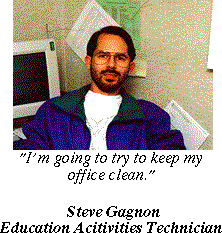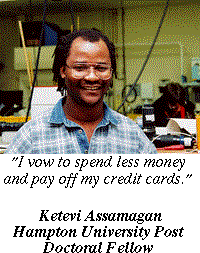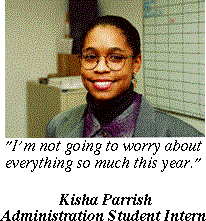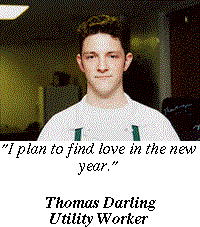Year in Review
Cynthia Keppel
CEBAF joins resources with local universities
CEBAF graduate students gain experience while continuing their education
CEBAF Promotes Summer Educational Programs
African-American History Month Events
Recreation Activities for Everyone
Holiday Celebrations Scrapbook
CEBAF Strives in '95
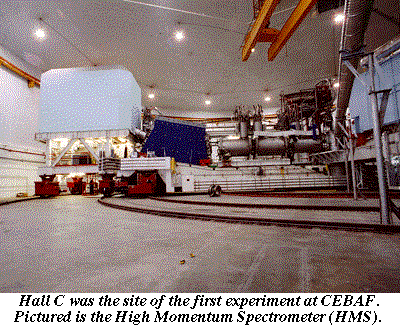 Nineteen hundred and ninety-five was marked by a year of "firsts" for CEBAF, and some very important accomplishments for the staff. On November 15, the years of teamwork, ingenuity and dedication of countless CEBAF staff and users resulted in the successful "christening" of Hall C. The first experiment began, and the laboratory entered a new era of exploration never before realized.
Nineteen hundred and ninety-five was marked by a year of "firsts" for CEBAF, and some very important accomplishments for the staff. On November 15, the years of teamwork, ingenuity and dedication of countless CEBAF staff and users resulted in the successful "christening" of Hall C. The first experiment began, and the laboratory entered a new era of exploration never before realized.
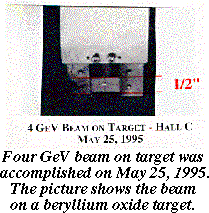 There were several milestones throughout 1995 that foreshadowed the historic event. On May 10, for the first time, the accelerator accomplished its design energy of 4 billion electron volts or 4 GeV. The beam traveled five times around the accelerator and was ready to transport to a target in Hall C. Later, May 25, a 4 GeV pulsed beam was delivered to a beryllium oxide target in Hall C. On November 4, the accelerator achieved a stable five-pass 100 kW continuous 4 GeV beam, a high average current beam which CEBAF was designed to deliver. Each event drew accolades from the physics community around the world.
There were several milestones throughout 1995 that foreshadowed the historic event. On May 10, for the first time, the accelerator accomplished its design energy of 4 billion electron volts or 4 GeV. The beam traveled five times around the accelerator and was ready to transport to a target in Hall C. Later, May 25, a 4 GeV pulsed beam was delivered to a beryllium oxide target in Hall C. On November 4, the accelerator achieved a stable five-pass 100 kW continuous 4 GeV beam, a high average current beam which CEBAF was designed to deliver. Each event drew accolades from the physics community around the world.
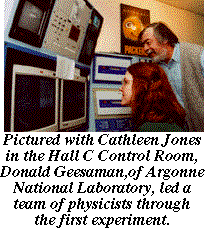 The experimental halls had successes as well. Hall C was successfully commissioned, and Halls A and B are close behind. In March, the toroidal magnet in Hall B reached full design current with a maximum magnetic field of 2.5 Tesla. This achievement represents a major milestone on the road to completion of Hall B equipment. One of Hall A's magnets, the electron dipole, has also tested successfully, meeting its design goals.
The experimental halls had successes as well. Hall C was successfully commissioned, and Halls A and B are close behind. In March, the toroidal magnet in Hall B reached full design current with a maximum magnetic field of 2.5 Tesla. This achievement represents a major milestone on the road to completion of Hall B equipment. One of Hall A's magnets, the electron dipole, has also tested successfully, meeting its design goals.
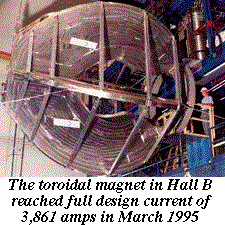 The Central Helium Liquefier (CHL), necessary for the successful operation of the accelerator, had its own series of accomplishments. A continuous run of 82 days marked the longest continuous run for the cold compressors which are necessary to produce liquid helium at a super cold temperature of 2 Kelvin (negative 456 degrees Fahrenheit). A stand-by refrigerator was initiated this year to maintain the accelerator at 4.5 K when the CHL is shut down for regular maintenance. And the End Station Refrigerator sustained runs for extended periods, successfully cooling the magnets in Halls A and B.
The Central Helium Liquefier (CHL), necessary for the successful operation of the accelerator, had its own series of accomplishments. A continuous run of 82 days marked the longest continuous run for the cold compressors which are necessary to produce liquid helium at a super cold temperature of 2 Kelvin (negative 456 degrees Fahrenheit). A stand-by refrigerator was initiated this year to maintain the accelerator at 4.5 K when the CHL is shut down for regular maintenance. And the End Station Refrigerator sustained runs for extended periods, successfully cooling the magnets in Halls A and B.
The Free Electron Laser program made a few strides in 1995. It was the subject of a successful review by the Department of Energy in May. The U.S. Navy has shown a real interest in the project.
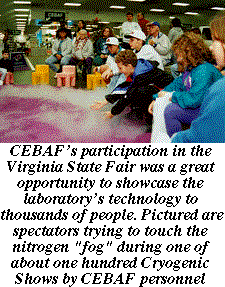 More people in the community and the state learned what CEBAF is all about. For the first time, CEBAF participated in the Virginia State Fair, which attracted more than a million visitors from Virginia and neighboring states. The historic year was also the first time the laboratory showcased its technology at the Internet Fair, EXPOTECH and Virginia Peninsula Total Quality Institute events. The annual CEBAF Open House in April, tagged this year as the Festival of Science, attracted more than 3,000 visitors.
More people in the community and the state learned what CEBAF is all about. For the first time, CEBAF participated in the Virginia State Fair, which attracted more than a million visitors from Virginia and neighboring states. The historic year was also the first time the laboratory showcased its technology at the Internet Fair, EXPOTECH and Virginia Peninsula Total Quality Institute events. The annual CEBAF Open House in April, tagged this year as the Festival of Science, attracted more than 3,000 visitors.
Personal accomplishments by CEBAF staff were many and varied. Henry Whitehead of the Accelerator Division, was honored by the African-American History Month Planning Committee in February for his 26 years of service and his dedication to science and the African-American community. In October, Whitehead received a CEBAF 10-year service award, along with 33 others, including Donald and Estelle Seeley, Roy Whitney, Anne Stewart, and Sandra Holmes.
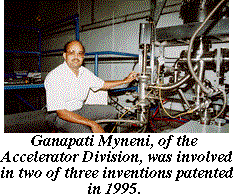 CEBAF received three new patents in 1995, bringing the total to six. The CEBAF scientists and their new inventions include: Javier Gomez, Stanislaw Majewski and Andrew Weisenberger for the invention of a Non Cross-Talk Multi-Channel Photomultiplier Using Guided Electron Multipliers; Ganapati Myneni for a High Sensitivity Leak Detection Method and apparatus; and Myneni and Peter Kneisel for the invention of a Metal Sponge for Cryosorption Pumping Applications.
CEBAF received three new patents in 1995, bringing the total to six. The CEBAF scientists and their new inventions include: Javier Gomez, Stanislaw Majewski and Andrew Weisenberger for the invention of a Non Cross-Talk Multi-Channel Photomultiplier Using Guided Electron Multipliers; Ganapati Myneni for a High Sensitivity Leak Detection Method and apparatus; and Myneni and Peter Kneisel for the invention of a Metal Sponge for Cryosorption Pumping Applications.
There were physical changes made to the site in 1995. Onnes Road was completed and a CEBAF sign was added to mark the new entrance to CEBAF. The Machine Control Center Annex was built to provide additional office space, and the plans were finalized for the Applied Research Center which will provide space for CEBAF and local universities.
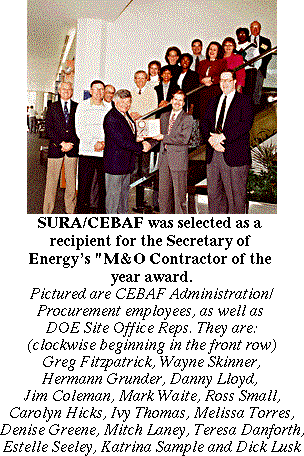 The bond between CEBAF and universities tightened this year with the celebration of existing programs and the creation of new ones. Partnerships with universities increased with the addition of three in 1995-the University of Texas at El Paso, New Mexico State University, and the University of Connecticut. One of CEBAF's first university programs celebrated a decade of hands-on physics education in 1995. Hampton University Graduate Studies (HUGS) program immerses second- and third-year graduate students in a friendly, rigorous regimen of lectures, research and presentations aimed at acquainting them with the physics that will be done at the laboratory over the next decade.
The bond between CEBAF and universities tightened this year with the celebration of existing programs and the creation of new ones. Partnerships with universities increased with the addition of three in 1995-the University of Texas at El Paso, New Mexico State University, and the University of Connecticut. One of CEBAF's first university programs celebrated a decade of hands-on physics education in 1995. Hampton University Graduate Studies (HUGS) program immerses second- and third-year graduate students in a friendly, rigorous regimen of lectures, research and presentations aimed at acquainting them with the physics that will be done at the laboratory over the next decade.
The newest program is CEBAF's Outstanding Undergraduate Physics Researchship which was implemented to provide a collaborative learning/working experience for outstanding physics majors. Four students were invited to work with CEBAF scientists and physics researchers for 10 to 14 weeks. The program will continue in the summer of 1996 with at least ten students.
For the fourth time, SURA was selected as a recipient of the Secretary of Energy's "M&O Contractor of the Year" award, for its small business achievements during Fiscal Year 1994. During a ceremony on March 31, 1995, in Washington, D.C., Secretary of Energy Hazel O'Leary presented the award to Danny Lloyd, CEBAF's Small Business Representative.
Jill of All Trades
From auto racing to physics, Cynthia Keppel does is all
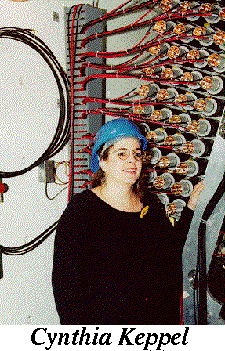 Even with such skills as sculptor, painter, and inventor, Leonardo DaVinci would still be envious of Cynthia Keppel. In addition to working as a faculty member of Hampton University (HU), and a CEBAF Staff Scientist, Keppel has been a race car driver, artist, high school teacher, and mentor. After receiving a liberal arts education at St. John's College, Keppel worked for a year and a half as a high school science teacher in Fairfax, Virginia. She enjoyed teaching the basics of science but says that "...teaching 120 students a day can be a challenge. Also, you [teachers] really don't get a chance to research, so it can be a little frustrating."
Even with such skills as sculptor, painter, and inventor, Leonardo DaVinci would still be envious of Cynthia Keppel. In addition to working as a faculty member of Hampton University (HU), and a CEBAF Staff Scientist, Keppel has been a race car driver, artist, high school teacher, and mentor. After receiving a liberal arts education at St. John's College, Keppel worked for a year and a half as a high school science teacher in Fairfax, Virginia. She enjoyed teaching the basics of science but says that "...teaching 120 students a day can be a challenge. Also, you [teachers] really don't get a chance to research, so it can be a little frustrating."
Keppel next worked for the Naval Research Laboratory in Washington, D.C. At the laboratory, Keppel was able to use her artistic skills to create a computer generated film to be used by scientists studying solar reactions. During this time, Keppel also entertained the idea of following in her father's footsteps and becoming a professional race car driver. She participated in the Sports Car Club Of America's Mid-Atlantic Road Racing Series. Instead, a lifelong interest in the basic nature of matter prevailed as Keppel chose to pursue a Masters of Science degree and Ph.D. in Physics at the American University.
"I was always interested in the basic structure and origin of matter," says Keppel. Her desire to become a physicist was solidified by a lecture given by Ray Arnold. "What Ray's talk did was show me a way that I could study these things myself," says Keppel. Arnold would later serve as Keppel's academic advisor. Once she graduated, Keppel worked at Stanford Linear Accelerator Center (SLAC) and then came to CEBAF to work in the dual capacity of a staff scientist at the laboratory and a faculty member at HU.
"I am lucky to be participating in the commissioning of CEBAF after all the years the project has taken. It is very similar to the physics program at HU in that a lot of work went into the program. We are getting ready to graduate our first Ph.D., and that sort of achievement generates a great deal of energy and excitement," says Keppel. Her scientific attention at CEBAF has been focused on the commissioning of Hall C instrumentation, a research proposal for a 6 GeV experiment that may lead to a better understanding of the structure of the nucleon and a laser backscattering project.
The backscattering project consists of a laser beam that will be shot into the accelerator's electron beam. The laser photons will be scattered from the beam and will enable scientists to continuously monitor the beam's energy without beam degradation. Another effort based on the same concept but utilizing an ultraviolet laser will boost the energy of the photon beam to make a high energy photon source for experimentation purposes. Keppel is working in conjunction with NASA's Langley Research Center on the backscattering project.
Keppel has sought opportunities to encourage others to become active in science. Last Summer, Keppel was a mentor in CEBAF's SITE program. She mentored four high school teachers in a number of scientific projects that were designed to expand the participants' scientific horizons while adding value to the laboratory's mission. Keppel has remained in contact with one of the participants. She and the teacher are developing a proposal for implementation in the teacher's school with the intent of encouraging more girls to enter the scientific field. "I am serious about education. If we have an opportunity to improve any learning environment, we should try," says Keppel.
While Keppel's time is at a premium, she says she still enjoys painting. In addition to her many, varied interests and responsibilities, Keppel is married to Barry Hellman, and has two sons, Barry III age 9, and Joel, age 2.
Written by Will Conners, Director's Office Intern
Partners
CEBAF joins resources with local universities
The CEBAF University Partnership Program is the very essence of a win/win situation. Like all good symbiotic relationships, CEBAF and universities derive unique benefits from a mutual association. Through the program, CEBAF draws on resources and energies of the academic community, while universities gain access and experience researching at a world class research facility. Tidewater universities that have partnerships with CEBAF are: Christopher Newport University, Hampton University, Norfolk State University, Old Dominion University, and The College of William and Mary. The equipment built, tested and designed by universities is central to CEBAF's experimental capability. A brief overview of contributions made by area universities follows:
"The partnership has been of inestimable value to CNU. It has provided many of our students with the opportunity to engage in meaningful, substantive research projects in a professional scientific community," says CNU professor Dave Heddle.
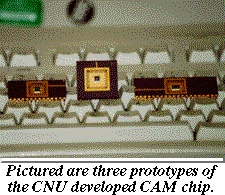 CNU's team of students and professors are involved in the extensive development of software which will store, interpret and measure the quality of research data. An advanced computer chip, called the Content Addressable Memory Chip (CAM), has been developed by the team. CNU's other major project is the design and assembly of the hardware triggering system for the CEBAF Large Acceptance Spectrometer (CLAS). Heddle expects that his group's role will shift as CEBAF transitions from development to full experimentation. "We will maintain our role in the trigger/data acquisition/software aspects of CLAS shifting a bit from design to maintenance," says Heddle.
CNU's team of students and professors are involved in the extensive development of software which will store, interpret and measure the quality of research data. An advanced computer chip, called the Content Addressable Memory Chip (CAM), has been developed by the team. CNU's other major project is the design and assembly of the hardware triggering system for the CEBAF Large Acceptance Spectrometer (CLAS). Heddle expects that his group's role will shift as CEBAF transitions from development to full experimentation. "We will maintain our role in the trigger/data acquisition/software aspects of CLAS shifting a bit from design to maintenance," says Heddle.
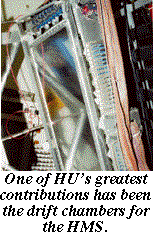 HU's greatest equipment contribution has been the HMS drift chamber project. The chambers are the primary instruments used in conjunction with magnetic spectrometers to determine the momentum of charged particles resulting from nuclear reactions. Other contributions include a split pole spectrometer to identify scattered electrons, data analysis software for Hall C, and a neutron polarimeter which will identify electrically-neutral neutrons resulting from nuclear interactions.
HU's greatest equipment contribution has been the HMS drift chamber project. The chambers are the primary instruments used in conjunction with magnetic spectrometers to determine the momentum of charged particles resulting from nuclear reactions. Other contributions include a split pole spectrometer to identify scattered electrons, data analysis software for Hall C, and a neutron polarimeter which will identify electrically-neutral neutrons resulting from nuclear interactions.
Keith Baker, a CEBAF Staff Scientist and professor at HU, says the relationship between the university and the laboratory will continue to grow. "Since there are a lot of experiments proposed by scientists who are far away from the site, I see the local universities being called upon more and more to contribute as the local expertise," says Baker. He adds that a university's capacity to serve as a resource during experiments will be necessary when experimental scientists must return home.
What began with a single faculty member several years ago has blossomed into a successful series of collaborations for Norfolk State University. The school's involvement with CEBAF includes work on the Focal Plane Polarimeter for Hall A, participation in the Free Electron Laser project, and the assembly of large scintillation counter arrays for two experiments. NSU has contributed to the first experiment in Hall C by providing a polyurethane helium bag which creates a low-mass path for the beam. The bag did not survive the high levels of radiation so NSU replaced it with a metal tube.
As one of the largest historically black universities in the United States, NSU says their partnership with CEBAF plays an important role in promoting science related education in the African-American community. "We hope to stimulate more African-Americans to go into scientific careers. The combination of CEBAF and NSU is the key," says NSU professor Ken McFarlane.
ODU, which has one of the largest groups with six experimentalists and five theorists, is making a number of contributions in CEBAF's three experimental halls. In Hall C, the group constructed the scintillator hodoscopes for the Short Orbit Spectrometer to detect the passage of charged particles. In Hall B, ODU is building the Region-2 Drift Chambers for CEBAF's Large Acceptance Spectrometer which will measure the trajectories of passing subatomic particles. Hall A is benefiting as well from the development of physics analysis software and a beam current measuring device.
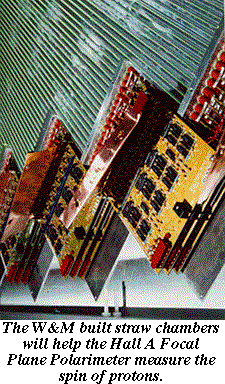 ODU faculty member Larry Weinstein says that CEBAF is central to the university's physics program. "The group was founded to take advantage of CEBAF's resources. We enjoy a very good working relationship," said Weinstein.
ODU faculty member Larry Weinstein says that CEBAF is central to the university's physics program. "The group was founded to take advantage of CEBAF's resources. We enjoy a very good working relationship," said Weinstein.
W&M's efforts have primarily focused on Halls A and B. The university is constructing two large area straw tube tracking detectors for the Focal Plane Polarimeter. The general use instrument measures the degree of polarization of particles. "One of the characterizing properties of strongly interacting particles is their spin dependence," says W&M professor and physicist Charles Perdrisat.
The school is also working on the electronic trigger for the Hall A spectrometers, a complex light guide system for the shower detectors in the Hall B CLAS, and are spearheading magnetic field measurements in the central region of the CEBAF Large Acceptance Spectrometer (CLAS). W&M physicists are co-principal investigators in nine approved experiments in Halls A and B.
Written by Will Conners, Director's Office Intern.
Crossroads
CEBAF graduate students gain experience while continuing their education
T he path of education has no end. A traveler starts off with a high school diploma and then moves on in search of a college degree. From there the road-weary hiker can choose to move on to graduate school to obtain a masters or doctorate degree. After this milestone has been reached, there are real-world experiences to be learned. For some graduate students, CEBAF has become a crossroads of sorts where academics meet the real world. The laboratory allows graduate students to gain experience in a work environment while enabling them to complete their degrees.
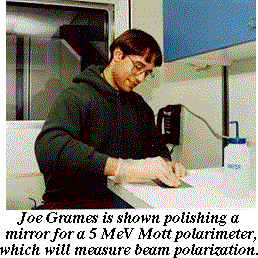 Joe Grames is one such student. Grames is seeking his Ph.D. in accelerator physics through the University of Illinois at Urbana-Champaign (UIUC). Working for Larry Cardman of the Physics Division, Grames' focus is on creating mathematical modeling and computer simulations of what happens to an electron's spin while it is going through the accelerator. "The information we get from these simulations will help CEBAF prepare for transporting a polarized beam through the accelerator and will help us to better understand the operation of the machine," Grames says.
Joe Grames is one such student. Grames is seeking his Ph.D. in accelerator physics through the University of Illinois at Urbana-Champaign (UIUC). Working for Larry Cardman of the Physics Division, Grames' focus is on creating mathematical modeling and computer simulations of what happens to an electron's spin while it is going through the accelerator. "The information we get from these simulations will help CEBAF prepare for transporting a polarized beam through the accelerator and will help us to better understand the operation of the machine," Grames says.
Grames believes the three to four years of time he will spend here will give him a broad understanding of accelerator physics, operations, and control. However, he would also like to see some form of regular, graduate-oriented classes in which the participants can continue to broaden their education while at the laboratory. "CEBAF involves a wide variety of physics with people of various expertise. It would be beneficial to a person, such as myself, who is studying accelerator physics, to have the opportunity to learn more about accelerator or nuclear physics in a classroom or seminar setting," says Grames.
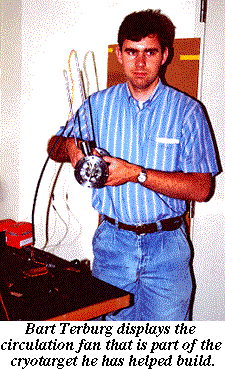 Like Grames, Bart Terburg comes from UIUC and is also working towards a Ph.D. in physics, but with a concentration in nuclear physics. Terburg works for Joe Mitchell of Hall C Physics. Since his arrival at CEBAF, his work has been concentrated on the construction of the Hall C multiloop cryogenic target. During the project which is near completion, Terburg helped in any way he could from turning wrenches to doing some small procurement work. He is currently involved in developing the computer controls for the target.
Like Grames, Bart Terburg comes from UIUC and is also working towards a Ph.D. in physics, but with a concentration in nuclear physics. Terburg works for Joe Mitchell of Hall C Physics. Since his arrival at CEBAF, his work has been concentrated on the construction of the Hall C multiloop cryogenic target. During the project which is near completion, Terburg helped in any way he could from turning wrenches to doing some small procurement work. He is currently involved in developing the computer controls for the target.
As a Fulbright scholar from the Netherlands, Terburg is thrilled to be working in an American laboratory such as CEBAF. "In America there seems to be more money and resources available for physics research," he says. The cultural diversity of the laboratory is another characteristic that he cites as an asset to his graduate experience. "It is wonderful to be working with such a varied group of people with so much expertise," says Terburg. "Everyone is able to work so well with each other because the language of science is universal," he adds.
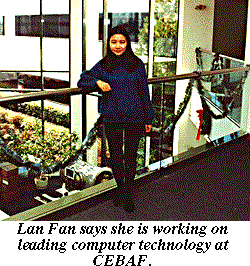 Lan Fan is another overseas student who is excited about her experiences at CEBAF. Fan, a William and Mary graduate student studying computer science, is working under the guidance of Rita Chambers in the Computer Center. Among her duties are general computer system administration work and helping out on the Distributed Informatics Access Management (DIAM) project. DIAM's purpose is to protect information available on CEBAF's computer network by authenticating and authorizing access to resources.
Lan Fan is another overseas student who is excited about her experiences at CEBAF. Fan, a William and Mary graduate student studying computer science, is working under the guidance of Rita Chambers in the Computer Center. Among her duties are general computer system administration work and helping out on the Distributed Informatics Access Management (DIAM) project. DIAM's purpose is to protect information available on CEBAF's computer network by authenticating and authorizing access to resources.
Fan finds the experience invaluable. "Working in America at CEBAF, I feel that I am working on the leading edge of computer technology and I will be able to take this new knowledge and apply it to my country's [China] computer networks to help bring them up-to-date," she says.
Much of the work that these students accomplish at CEBAF, they say, influences their work on their graduate theses. Grames is using his experience to prepare an experiment to precess the electron's spin by perturbing the beam orbit in order to learn more about the workings of the accelerator. Terburg's experiment concerning the photodisintegration of the deuteron into a proton and a neutron will use the cryotarget that he helped construct. Fan is considering developing a thesis based on the work she has done on the DIAM project.
Many of CEBAF's regular staff members appreciate the presence of the grad students. Rita Chambers, Computer Center Manager and Fan's mentor, says, "One of the best facets is having someone who can devote time and energy to projects without some of the normal business commitments that our other staff encounter. Lan has had the time to fully explore in-depth capabilities like the World Wide Web and has then been able to share her findings with the staff."
Joe Mitchell, Terburg's Physics mentor, echoes Chambers' thoughts. "CEBAF's mission is to put physics first and foremost and it would be difficult to accomplish it without a pool of highly motivated students," he says. "It is a good deal for all concerned. We get good, intelligent workers at bargain basement prices and the skills they learn in the process, will make them more appealing candidates for jobs in any high-tech field," Mitchell adds.
Written by David Ellis, Director's Office Intern.
CEBAF Promotes Summer Education Programs
HUGS
CEBAF has one particular program that is designed to specifically benefit graduate students. On June 2-19 CEBAF will run the Hampton University Graduate Studies (HUGS). The program is in its 11th year. HUGS is intended for second and third year physics graduate students who have finished or nearly finished their coursework. Students who are well into their coursework are also encouraged to apply. Hampton University awards from one to six credit hours to the program's participants.
The program consists of an intensive series of lectures and seminars that are given by CEBAF scientist and invited guests from universities world-wide who are leaders in their particular field of research physics. Each student will document a specified lecture topic. The curriculum allows for a great deal of interaction between the students and the lecturers.
Acceptance to the program is on a competitive basis and there is the opportunity to qualify for a fellowship. Fellowships cover the cost of tuition and fees, room and board, and cost of travel (from U.S. point of entry for a foreign student). Daily transportation will be provided for all participants.
An application deadline has been set for March 8,1995. For application materials and other information please contact Carlane Pittman at (804)727-5928 or e-mail at pittman@jlab.org.
Applications and other correspondence for HUGS should be sent to:
Dr. José Goity
Chair, Local Organizing Committee
Nuclear/High Energy Physics (NUHEP) Research Center of Physics
Hampton University
P.O. Box 6172
Hampton, VA 23668
COUPR
This summer will mark the second running of the CEBAF Outstanding Undergraduate Physics Research-ship (COUPR) program. COUPR is designed to provide a collaborative learning/working experience for outstanding physics majors. Participants will work closely with CEBAF scientists and physics researchers. Only 10 students will be invited to participate in the competitive 10-14 week program. The program will select students based on academic achievement, interest in CEBAF-related physics, and recommendations. An emphasis will be placed on attracting minority students in order to promote diversity in the physics community.
CEBAF staff/users with university connections are strongly encouraged to inform their students about the COUPR program.
An application deadline has been set for April 15, 1996. For more information and application materials please contact Erica Murray-Hirabayashi at ext. 7883 or emurray@jlab.org.
Briefly...
African-American History Month Events
This year's celebration at CEBAF promises to influence many future scientists and engineers. The planning committee has organized events they hope will educate and entice the CEBAF community to participate in the celebration of African-American History Month. Crittenden Middle and Warwick High Schools were chosen as schools to target for an essay contest which will bring the winners to CEBAF for a day. Guidelines have been distributed to the students asking them to write an essay on an African-American who has made a significant contribution to science and/or technology. Twenty-five winners will be paired with a CEBAF mentor to shadow on February 28, 1996. A CEBAF overview, cryogenic show, science presentation, award ceremony and site tour are also on the agenda.
To top off the experience, the students will also be invited to participate in CEBAF's International Food Festival, to be held 2-4 p.m. the same day. All CEBAF personnel are invited to prepare a dish which best represents their culture for the food festival. Last year's food festival was a great success. The committee would like to repeat the enjoyable event on a grander scale with the objective of continuing to promote appreciation and awareness of cultural differences.
Another event planned for the month is a Science Series presentation entitled, "Lasers and Ultrafast Optical Phenomena," by Anthony M. Johnson, Physics Department Chair for the New Jersey Institute of Technology. He will speak on the evening of February 27, 1996.
Everyone's participation is encouraged. For more information, please contact Deborah Hyman at ext. 4852.
Recreation Activities for Everyone
The CEBAF Recreation Committee (CRC) is the latest group to place a web site on the Internet. The CRC's homepage provides information on upcoming events, instructions on how to join an e-mail group, and surveys which rate CRC events. The web site can be found at http://www.jlab.org/news/crc.html. The CRC has booked two nights for Admirals hockey games this year at Norfolk Scope. On Friday, February 9 the Admirals take on Roanoke, and Saturday, March 16 they face off against Richmond. Tickets may be reserved for $8 at the CEBAF Center reception desk. Ticket deadline for the February 9 game is February 2 at 5:00 p.m. Deadline for the March 16 game is February 23 at 5:00 p.m. For more information contact Eric Woodworth at ext. 7217 or at woodworth@jlab.org.
The CEBAF bowling league has already gotten under way. The league, which meets at Denbigh Lanes on Monday nights at 6:15 , has already established teams, but is looking for bowlers who are willing to come in on a substitute basis. The cost per night is $7 plus a one-time sanction fee which is $10 for men and $11.50 for women. For more information call Eric Woodworth at ext.7217 or Julie Oyer at ext. 7120.
Let's all go to the circus! The Ringling Brothers Circus is coming to the Hampton Coliseum and the CRC has seats reserved for 7:30 p.m. February 29. Three rings of non-stop action, unlimited excitement and fun-filled family entertainment. Tickets may be reserved for $13 each for children and adults at the CEBAF Center reception desk. Deadline is February 9.
Also, keep an eye out for information on a Spring Golf Tournament in April.
Holiday Celebrations Scrapbook
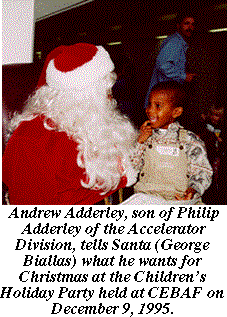
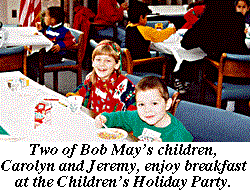
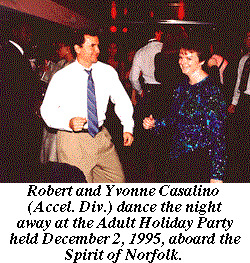
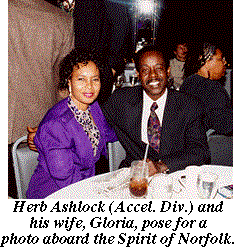
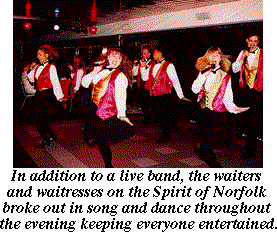
New Year Resolutions
What's Yours?
